The Cold Steel Bushman has been in my possession for quite some time now. Publishing the review has been delayed over and over again, in most part due to my own mixed feelings over this iconic knife. Traditionally, I tend to pick up a knife and I can have a general idea of how it will perform, whether it’s a solid buy, etc., but with the Bushman, one year later and I am still just as indecisive as I was before. The longer I own it, the more I am torn.
As a side note, if we weren’t so formal about our titles, we would’ve named this one – “The review in which I quite literally bled all over the product.” Just thought it’d be good to mention as a little heads up.
 Cold Steel Bushman Fixed Blade Outdoor Knife – Amazon / Blade HQ
Cold Steel Bushman Fixed Blade Outdoor Knife – Amazon / Blade HQ
Cold Steel’s Bushman is an exceptional tool – for the price. This is a preface you will see a lot in this review. The Bushman delivers a solid option for 20 bucks, with a slew of features and benefits that are unmatched at this price point. I am not saying this to preemptively make excuses about some of its flaws (spoiler alert: it has many), but rather to emphasize its purpose.

The Bushman is solid tool. It’s not a woodworking blade or even a bushcraft blade. It is, rather, a single piece survival option designed from the ground up for resilience and flexibility of use.

As is obvious when you first see it, this is a hollow handle knife, but unlike the bulk of cheap Rambo-style knives, this particular slab of steel is literally just that: a single slab of steel rolled inward to form a handle. It has no joints, seams, or anything that could indicate a weak point.
This is the greatest thing about the Cold Steel Bushman, and possibly the worst. It’s very tough – but not particularly comfortable out of the box. The hollow handle design will reverb through your arm should you chop with it (more on this later), and to maintain a 20 dollar price point, sacrifices have been made with regards to cutting performance.

The knife looks decently finished. The Bushman has a solid SK-5 high carbon steel blade (and handle) which has been powder coated very nicely. The primary grinds look well defined and the edge is certainly evenly buffed, which is shocking taking into account the price. I have handled a lot of knives at much high price points with jagged edges and a poor final edge.
Cold Steel has a reputation for putting an excellent edge on their knives and the Bushman is no exception. I am very impressed with what is on offer here. Sadly, its bias towards toughness means the blade is very thick behind the edge. Thicker than any of my choppers.
It almost seems like you are holding a machete that has had a nice, even buffing job on the final edge. It is sharp, but penetration and cutting ability suffers, as you will see once we get to the meat of this review.

The Cold Steel Bushman is 2.5 mm thick. This might seem thin to you, but I promise this knife can handle rough work. This ain’t a slicer by any stretch of the imagination, and that’s due to the grind – not the stock thickness. It has a single transition on the edge that is less that 1 inch in height and doesn’t drop to a particularly acute edge.
Other than that, as you can see below, the spine of the knife goes seamlessly into the handle. It’s a very interesting design that tends to elicit curious questions from non-knife people. I like interesting quirks in my knives and this certainly meets the criteria. I own no other hollow handle knives and, other than neck knives, I own no other one-piece knives either.
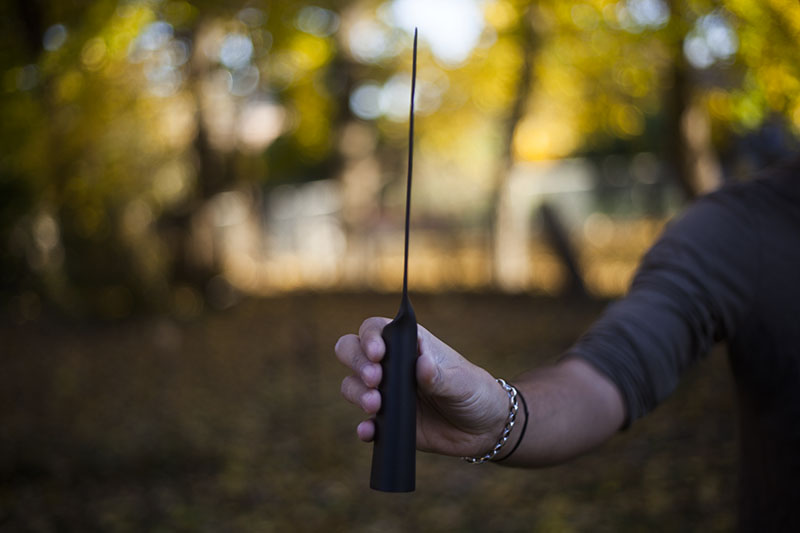
From a wilderness perspective, the Cold Steel Bushman is less than optimal out of the box. The blade is very thick behind the edge and I think a couple of hours with some sandpaper would improve the Bushman greatly. It’s definitely something I will personally do.
However, out of the box it bites into the initial 1 mm of wood and then has the annoying habit of skating across the rest. It’s a design flaw, not a manufacturing one. With that said, for softwood, it’s perfectly fine and from a toughness perspective, the thick edge certainly helps – the Cold Steel Bushman could baton through a steel nail and any damage would be superficial at worst.
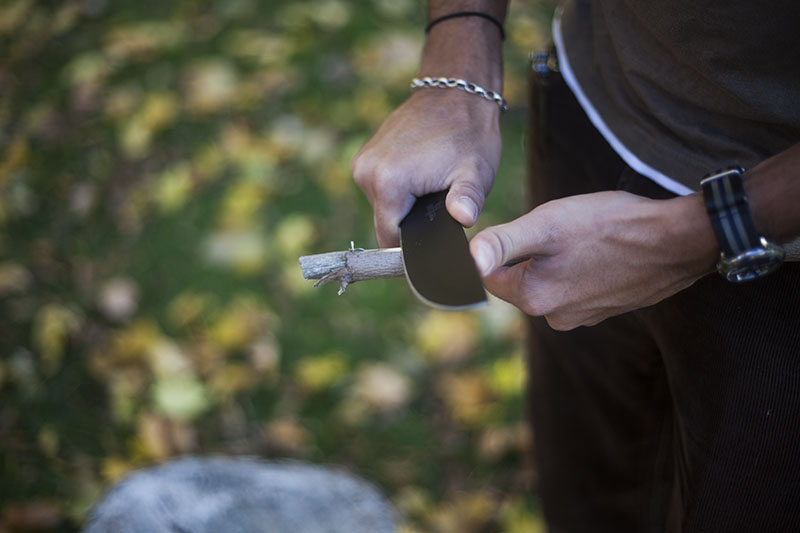
This is not to say that the Bushman can’t carve or cut, but that a Mora, Condor Bushlore, or any other more wood-oriented blade would do it with far less effort and have generally far superior results.

The lack of traction on the handle as well as the effort required for the edge to bite in means that I don’t find using this knife pleasurable in the slightest when carving. I view it more as a necessity should the occasion call for it.

Right behind the edge, it’s almost the full thickness (2.5 mm) of the stock. It’s a giant bottleneck that hampers this tool from being a solid Bushcraft option out of the box. You can also see the tip of the blade – very obtuse. It seems that an edge was applied all across the knife with no supporting bevel. Definitely consider putting some elbow grease into it with a belt grinder, stones, or sandpaper. The payoff would be immense.
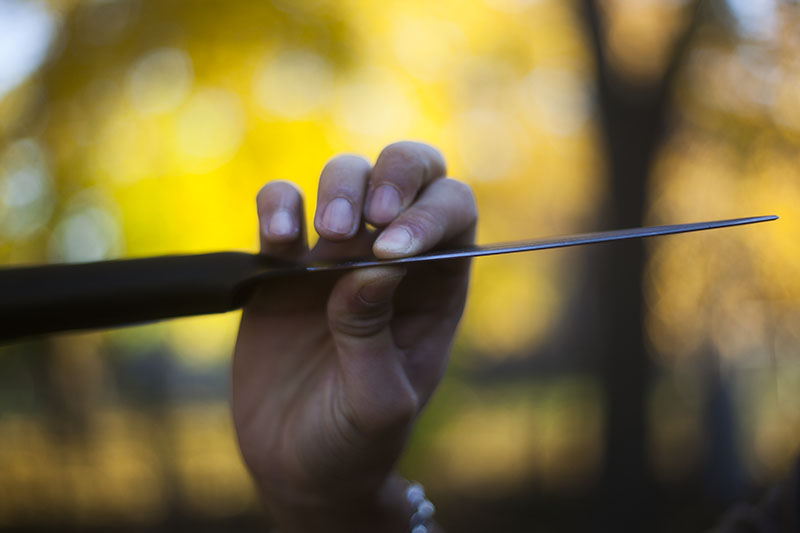
Chopping is equally non-optimal. The knife just likes to bounce off the wood, taking with it small chips. Another downside, as I mentioned earlier, is that the hollow handle and the lack of scales/cushioning material will carry vibrations right into your arm. Not pleasant at all, but easily solved by wrapping the handle with hockey or baseball grip tape.


One of the flagship features is the ability to convert the Bushman into a spear – very cool in theory. In practice, I’d say it worked out just fine (though this is where the bleeding began – not the easiest thing to do on the hands).
Find a stick with a thicker cross section that looks reasonably tough. Don’t worry about the bark or knots as you will whittle those away.

Rest the stick tip down and roughly chop it into a rudimentary spear point. Don’t overdo it as you don’t want to add weak points.
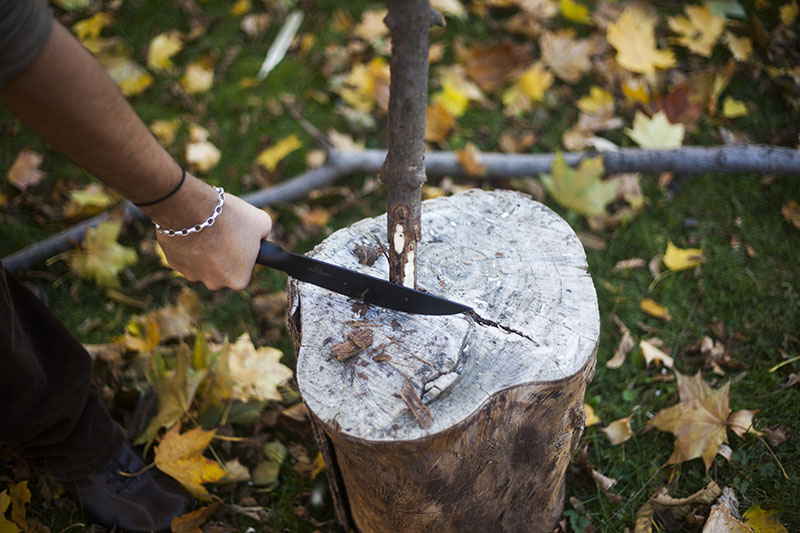
Finally, wedge the stick into the handle of the knife and you are done this part. I would suggest making the shaft of the spear thick enough that you really do have to wedge it in. The screw hole, whilst useful, is more of a secondary safety/fastener rather that the main attachment point.
You want the tight fit to be the primary reason why the spear stays together.

It doesn’t come with a screw, but any steel wood screw that has a wider head than the whole, and is shorter in width than the handle, will suffice. I didn’t overthink my decision.

I suggest bracing the shaft against a log or other surface prior to screwing. I do not suggest screwing it in whilst holding the knife in your hand: it’s not safe and will make your life much harder.
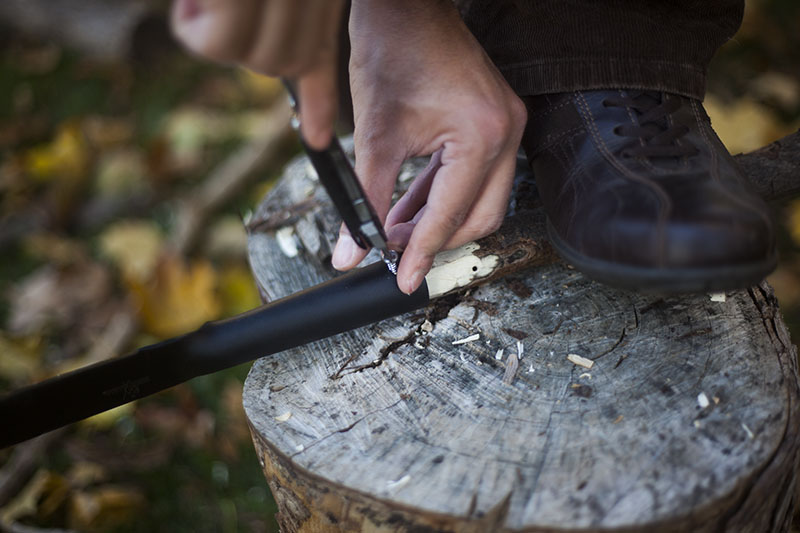
And here it is all done. A significant increase in reach with little to no work. The blade is 7 inches long (the knife itself is 12.25 inches overall) and the conversion into a spear can turn a close range weapon into a distance creator.

Definitely better than a knife against bears. Personally, I wouldn’t want to face a bear with just this spear, but it’s better than a knife, and frankly, push comes to shove – I’ll take whatever I can get. Options are good even if they are not ideal.

To test penetration and the shaft’s ability to remain within the handle, I opted to slam the spear into a log section and see if I could lift the log without the whole thing coming apart.

Pretty damn impressive – both its penetration (a time when 2.5 mm of stock thickness comes in useful) and its well implemented design. Without the screw hole, I don’t think it would have held.

For some reason, after this little exercise, I was unable to remove the screw, but thankfully I had a few knives with me that day. I went with my Schrade SCHF9 to turn this spear back into a knife.
 Schrade SCHF9 Fixed Blade Outdoor Knife – Amazon
Schrade SCHF9 Fixed Blade Outdoor Knife – Amazon
Chopping with a real chopper after using the Bushman was a shock all in itself; right tool for the right job seems to ring appropriate. A thick slab of steel with a lot of weight behind it eviscerated the shaft in one fell swoop. It wasn’t so much the cutting performance, but rather the sheer amount of brute force a chopper can bring to the table.
It makes the Bushman seem almost puny by comparison. Then again, the Scrade is twice the cost and doesn’t have the Bushman’s versatility, so as with everything, there are always pros and cons.
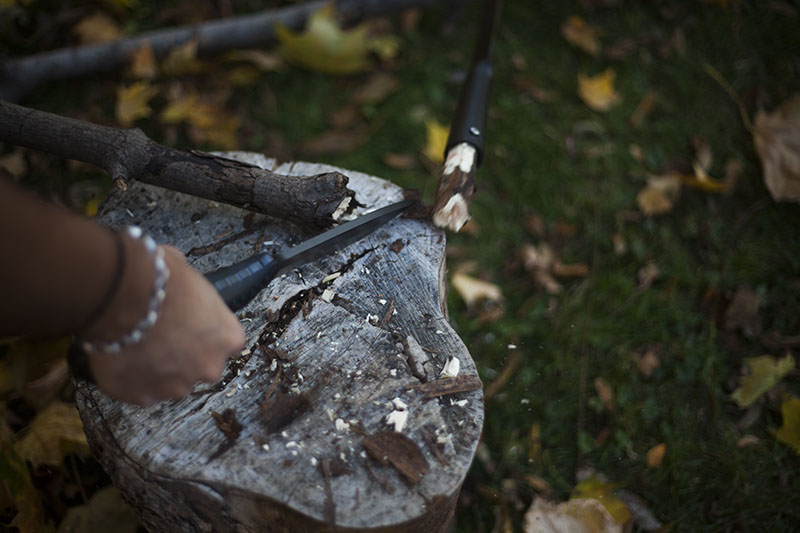

Batoning with the bushman is frustrating. Again, it’s not a question of toughness or the final edge, but rather that you are dealing with a 2.5 mm thick slab of steel with no real edge transition and no vibration support on the handles (nor grip). Not fun at all, but still functional.
The Bushman is the sort of blade that can check every box, but in an ideal situation, you wouldn’t want to use it for very much as a primary tool.

The wood is still lodged into the handle (since the autumn, as you can tell by the pictures) I will have to drill it out one of these days!

After these light tests, the edge on the Cold Steel Bushman was still perfect (as expected) and I moved on to try out its other features.
I might add that the coating is of reasonably high quality. This isn’t a paint job. It works.
Unlike paint, it won’t chip off, but as a coating, it will slowly wear down over time. A clear upgrade from the glorified paint job on the Cold Steel Recon 1.

The tip is very obtuse. Drilling into wood is, once again, technically viable, but not something it excels at. As a point of comparison, the Schrade SCHF9 that you saw earlier has a more acute tip. Yeah – the monster that is 3 times as thick has a more acute point.

The Bushman comes with a firesteel attached to the sheath. It didn’t play nice with the spine of the knife, so if you want to use it, you will need to either square a section of the spine with a file or use the edge.
When using the edge – no problemo.

Sadly, the firesteel came apart after first use, and cut me (cut #2) in the process. The firesteel itself is glued in, and not very well at that.
Strongly recommend ripping it out and adding epoxy.

The ergonomics are basically what you would expect. Hold a broomstick – now imagine it’s made of steel and weighs 10 ounces.
You got it.
Neutral and comfortable when your not actually putting pressure on it. I would strong recommend adding grip tape to the handle, though; it’s a very cheap modification that will pay dividends should you ever have to use it for prolonged periods of time.

Choking up is viable, once I regrind this blade, I might use it as a garden knife to throw around or perhaps as a loaner. It’s reassuringly solid and cheap enough that I don’t feel attached to it at all. It’s not a delicate blade but its lightness makes it a viable “all rounder.”

Reverse grip is a terrible idea. No guard and a slick coating makes this an accident waiting to happen. From a tactical perspective, I don’t recommend this blade unless you modify it significantly or use it as a spear.

Absolutely no damage to the edge. Again, unsurprising taking into account how obtuse it is.

Now, for the sheath, you will be happy to hear that the Secure-Ex sheath is extremely solid. For the price, it eclipses the sheaths provided on any of my similar blades, including Moras. It’s durable, functional, and well-designed, with the bonus of having a firesteel.
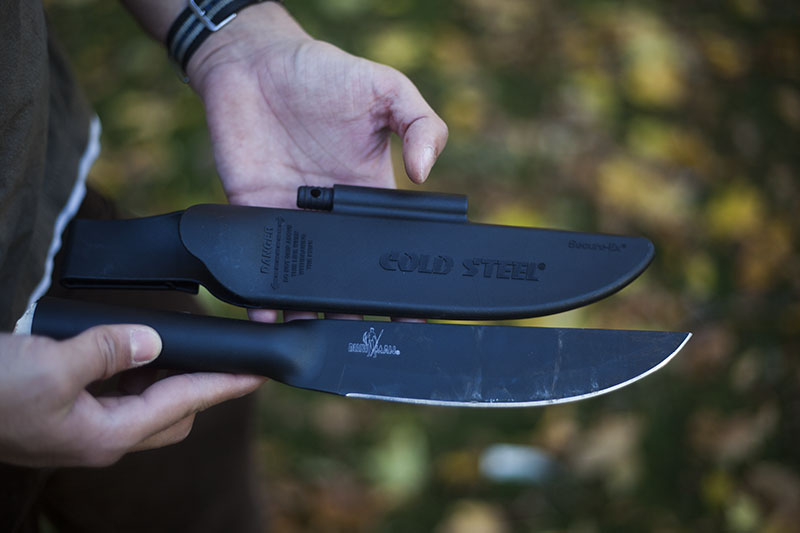
Secure-Ex refers to the clicky, lock-in tab that Cold Steel uses on many of their knives, including the SRK. It works with no frills or quibbles. Can’t ask for any more than that.

The belt loop is easy to put on and take off, thanks to its slide-on option. It might look flimsy, but in practice I found it very tough. The plastic is thick and has plenty of give.

No problem, and looks pretty damn good, too. Looking at the sheath, would you say this is a $20 knife?

As is standard nowadays with outdoor blades, a drainage hole. Good placement, which is important to know due to the SK-5 blade steel predisposition to rust if you look at it the wrong way.

The tab on the back of the sheath is the Secure-Ex mechanism/tab thingy. I took pictures so you wouldn’t mess with it like I did.

You are welcome. Thankfully, it popped back into place very easily. Just because there is a tab doesn’t mean you should rip it off (note to self). Unlike me, I would suggest being more responsible lest you break your new toy.

Retention still very solid. At least we know the design is well implemented.

As I was wrapping the review up, Elise raised the possibility that the sub-par cutting performance was due to the wood and not the knife- I quickly reached for the Schrade, and nope – can confirm, it’s the knife, not the wood.

One of the coolest looking knives on the block right here. The Cold Steel Bushman screams utilitarian purpose. I can’t think of any knife that personifies the anti-thesis of bling more than this. No shinies, cut outs, or swedges. All business.

Reading this review, you might be inclined to think it’s quite negative, and there you would be wrong (especially if you realized just how far I’ve come to get to this level-headed perspective – believe me there was a lot of rage to be had when initially testing out this knife).
The Cold Steel Bushman is an excellent back up tool and a sub par primary knife. There is nothing wrong with that. The Bushman can handle anything you can throw at it. It might not be a light saber or great chopper, but it’s a solid dependable tool that will do whatever you ask of it – even if it leaves your hands with blood and blisters in the process.
I can think of very few knives I would want as a beater, loaner, or as a truck knife. The Bushman is 20 bucks and comes with a decent sheath and firesteel. Is it fair to criticize Cold Steel over the Bushman’s overly thick edge and lack of handle comfort? I don’t think so.
But would it work as a sole knife if you’re a one-knife-in-the-wilderness kind of guy? Sort of, but not really. You’re better off finding something else to use if that’s the kind of kit you’re working to piece together.
My suggestion is to buy this knife, regrind the edge, put some tinder in the handle and seal it with a cork and some hot wax. There you have a lightweight 20 dollar package for the outdoors that you can leave lying around or lend out. Perhaps put one in the cabin or give it to your son (or daughter) – it won’t break, it really just won’t, and if it gets lost, you won’t cry over losing it.
Sometimes versatility and price are advertising points in themselves, whilst performance takes a backseat, and I think the Bushman illustrates that point perfectly.
Thanks for the thorough review. Not sure if they’ve changed the blade grind since this but mine seems fine for wood. Definitely second the post to wrap the handle in paracord: it solves the vibration problem, makes slippage much less likely, and gives you a supply of cordage for lashing or other purposes if you need it. While the sheath retainer works, this is a knife to be careful with unsheathing. As the review points out, this is an unusually bloodthirsty knife
It’s not the best knife out there but it’s an excellent workhorse. It’s greatest weakness in my opinion is that it sacrifices comfort for versatility. Ergonomics matter. That said, the ability to turn it into a spear or long handled brush cutter is, also in my opinion, a worthwhile compromise. It’s great having a spear on hand when sleeping in a hammock in the woods.
All in all it’s a really good multitool, but like all multitools its versatility comes at the cost of performance. No multitool is going to be as good as a dedicated tool made for its purpose. Horses for courses.
Agree 100%. Solid, low cost option that sacrifices ergos for versatility. It is what it is.
I made this my primary knife in my BOB bag. You are entitled to thing what you want but I disagree with calling this a secondary blade.
Everyone has different experiences Joshua, and if the Bushman works for you, then all the better! My issue with it was just the feedback/vibrations and the ergonomics in general.
Have you tried more traditional bushcraft blades and how did they compare in your opinion?
I have to eat my words from my prior comment in Jan 2018 and have since gave away the Bushman after having a very close call with slicing my fingers from handle slippage even with Hockey tape handle wrap. At the moment I am using the Ontario hunt plus camp knife. Found it on sale for $20 and it is only 420HC Stainless. But it has served my needs pretty good. And the Spine on the Hunt plus camp knife is the best I have ever seen on any knife for shavings and Ferro rod striking I also carry a Mora Pro S and Pocket Bushman for back up. As much as I like the concept of the Bushman I can never recommend it again due to no Guard or finger cut out behind the blade to help with a more secure grip. I have also relegated Carbon to strictly Machetes and gravitated more to Stainless knives for easier maintenance. I have since bought a GI Tanto I have been thinking on trying out in the bush. But so far it has sat on the shelf.
Yeah, safety is definitely questionable ;). Glad it was a close call and nothing permanent. Lesson learnt in any case! Never played with the GI Tanto- its been out forever but for some reason I keep looking over it.
Also forgot to mention the Sheath retention piece on the Secure Ex came loose on mine with no way of reattaching causing the knife to be very prone to slipping from the sheath.
With modifications it is a good hunting and preper tool. 50 mm x 6 mm long Pin inserted through handle at blade end makes an efficient finger guard. Wrap the handle in para cord and no more slip when hands are wet, plus can be used to secure knife to pole. Put screw top container in handle for dry storage and cap handle with rubber walking stick cushion. I have made heavier hunting knives but it was the adaptability of this knife that sold me on it for a hunter or preper.
I have had mine for years.I keep mine on a 6 ft ash home made walking stick/spear For hiking,woods walkabout mine has the older nylon sheath with sharpener.It throws well,is balanced,holds a good edge.Blade is removable fairly easy for hunting survival knife applications
I have had many knives over the years,even some customs that were pricey.I always seem to end up with a Cold Steel in my pack. The Bushman has always held a place in my heart,though I’m not sure why but it has always been there.With a little fine tuning it’s a great knife.When heavier work calls for something more,it’s a CS machete,or my CS tomahawk.I think they offer more choices than about anyone else in the field.
Recently I’ve added a Finn Wolf and Finn Hawk to my EDC pack and am very satisfied with both.
The Finn Wolf is amazing, one of the best folders I have reviewed (check it out!)- I have yet to try to Finn Hawk though- how does it handle compared to the finn wolf or a Mora? Looks like a Mora 740MG to me.
Thanks for dropping by Matt.
The Finn Hawk has a flatter handle profile than a Mora,I like it.Others I’ve read about don’t.I let a friend hold the Finn Hawk,she did not like the feel of the handle compared to the Mora Tri-flex I’d let her use the day before.Personally I like the Finn Hawk better.
The Finn Wolf is what I had been looking for,for a while.Though I had never been one to carry a folder clipped to my pocket,I always went for a neck carry(TOPS Shango).In my pocket I always had my SAK Farmer.I have yet to really use the Finn Wolf,but I have little doubt it will preform well within reasonable tasks-no stabbing of cinder blocks or battoning of telephone poles or trying to filet a car.
Just as a comparison-my favorite Bushcrafting knife for over ten years or so has been my Entrek Forester.
Thanks for the feedback Matt, looks like a solid little bushcrafter for the price. I have a feeling I will prefer the thicker Mora handles in terms of ergonomics but options are never a bad thing and I look forward to giving it a shot.
I own the Cold Steel Finn Bear (review to come…one day) and found the blade to be solid but the unusual grip style (triangular geometry) to be a bit off-putting. Maybe I just need to get used to it!
Good, thorough job. Only one thing to add. Store bandages in the handle of your Bushman for cuts. ;-)
;) Indeed Helen.
Please please please strike the ferro rod with the spine of the knife! you will not cut yourself or dull your blade.
Ideally, one would strike the ferro rod with the spine but unfortunately it requires a squared, uncoated section which this knife does not have (as I mentioned in the review).
Thanks for dropping by Kevin!
Thank you for the review. I have had a few of these (2 Bushman, 2 Mini-Bushman) and have these experiences. I’ve wrapped the handles with a single layer of 550 paracord, securing with sewing needles. Under this wrap I keep a pair of turkey cooking bags for water transpiration bags. The bare metal, left alone in full sun is VERY uncomfortable to grip.
I use a cup hook to secure the head to a pole. A screw eye would do as well, but the cup hook has other uses too. A short pole is easier to chop with (short axe length) because you get more momentum while still able to keep edge perpendicular to cutting surface.. A longer pole can cut very high branches you could not cut otherwise.
Spear use – meh. I think cutting the limb to a blade shape and fire hardening this (NOT burning it, just getting rid of inside moisture) works as well as the blade itself. I guess as a melee type of ‘get off me’ weapon, plenty effective.
Try the Mini Bushman – I’m happier with that one, the regular being too much of a good thing.
Thanks for sharing your thoughts Anon, I can’t promise I will get the Mini Bushman but I will certainly look at it.
I own the folding Bushman which will be reviewed soon’ish (this year).
Really thorough review, and I agree. It’s not a beauty or elegant in any way, but it’s a great beater knife, and was one of the first fixed blade knives I bought, years ago. I still recommend it to friends, if they just need a cutting tool and want a cheap, tough option.
Basically this. Its one of the toughest knives on the market for such an low price point. Gotta be impressed by that.
I think the original Bushman is very beautiful fixed knife ,the simplicity is great.